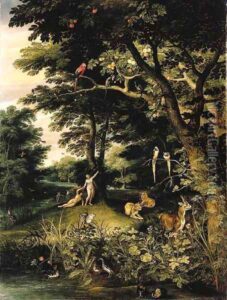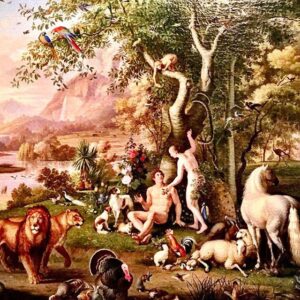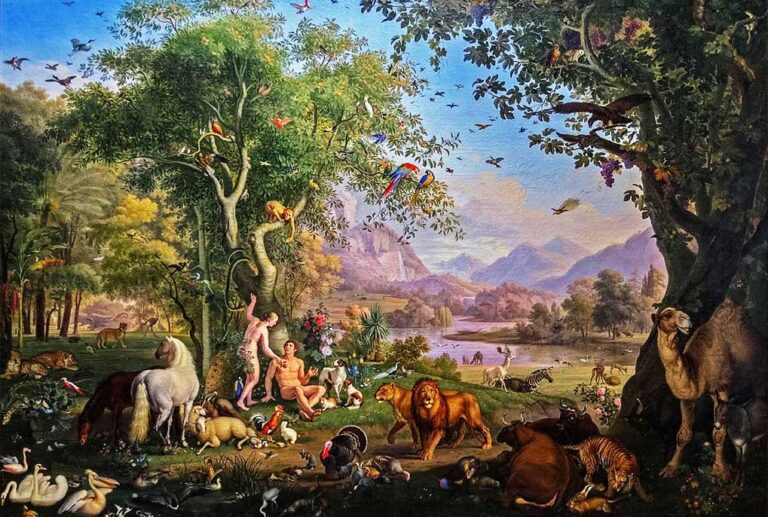Table of Contents
The Garden of Eden, a captivating and mythical paradise, occupies a central place in the narratives of Judaism, Christianity, and Islam. This sacred space is not just a physical location but a rich tapestry of symbolism and profound lessons.
Biblical Genesis
Nestled in the biblical Genesis, the Garden of Eden unfolds as an idyllic haven, adorned with lush greenery, vibrant blooms, and captivating landscapes. The narrative paints a vivid picture of perfection, where every tree bears luscious fruits and each stream glistens with crystal-clear water. The air is thick with the sweet fragrance of blossoms, and harmonious melodies resonate from the diverse array of creatures dwelling in this utopian sanctuary.
Amidst this earthly paradise, Adam and Eve, the first human beings, experience unparalleled communion with nature and God. Towering trees with broad canopies provide shade, creating serene spots for contemplation. Majestic rivers crisscross the landscape, offering life-sustaining waters that nurture the abundant flora.
In this divine garden, the Tree of Knowledge stands as a central emblem, its branches laden with tempting fruit. A symbol of moral choice and consequence, it becomes a focal point in the unfolding drama of the human narrative. As Adam and Eve navigate this pristine environment, their innocent existence unfolds under the watchful gaze of the Creator.
The animals, each with unique qualities, share the paradise with the first couple, fostering a sense of harmony. Lions and lambs coexist peacefully, symbolizing the absence of strife and predation. Birds of various plumage add vibrant hues to the heavenly canvas, creating a visual symphony that complements the utopian ambiance.
However, this paradise, while a testament to divine generosity, becomes the stage for the seminal moment of human choice and disobedience. The forbidden fruit becomes a catalyst for change, challenging the idyllic existence and setting in motion the consequential events that shape the course of human history.
Symbolism and Allegory

The Garden of Eden, a lush haven, symbolizes pristine beginnings, portraying humanity’s innocence in divine creation. However, despite this idyllic setting, the serpent’s temptation introduces a pivotal shift. Consequences unfold, and the forbidden fruit becomes an emblem of choice and its repercussions.
Transitioning from harmony to discord, Adam and Eve’s disobedience shatters the utopian facade. The expulsion from Eden marks a paradigm shift, symbolizing the loss of innocence and the entry into a world tainted by the awareness of good and evil.
Yet, the garden’s symbolism extends beyond punishment; it becomes a beacon of hope. The yearning for Eden persists, embodying humanity’s eternal quest for a utopian existence, a return to divine harmony.
As a timeless allegory, the Garden of Eden transcends its biblical narrative. It reflects the universal human experience, grappling with choices, consequences, and an enduring longing for an idyllic state.
In every culture, echoes of Eden resonate, weaving into the fabric of collective consciousness. It becomes a template for exploring themes of temptation, fallibility, and the persistent human desire for a lost paradise.
Despite the allegorical layers, the Garden of Eden remains a powerful narrative archetype. Its symbolism permeates literature, art, and philosophy, inviting contemplation on the human condition and the pursuit of an elusive, utopian ideal.
The Tree of Knowledge
At the heart of Eden, the Tree of Knowledge stands, symbolizing the boundary between innocence and awareness. Its forbidden fruits entice Adam and Eve, challenging the harmony of their existence.
Transitioning from blissful ignorance, the tree becomes a focal point, tempting the first humans with enlightenment. Eve succumbs to the serpent’s persuasion, disrupting the equilibrium of Eden.
Despite the warnings, Adam partakes in the forbidden knowledge, marking a pivotal moment in the biblical narrative. Consequences cascade, unraveling the pristine state of the garden.
The Tree of Knowledge, a catalyst for disobedience, serves as a metaphor for humanity’s perpetual struggle with moral choices. Its fruits embody the duality of good and evil, unleashing a cascade of events that shape human destiny.
Beyond the literal tale, the tree becomes a literary and philosophical symbol. It’s a recurring motif, echoing across cultures, representing the tension between wisdom and the consequences of its pursuit.
In every culture, the tree resonates, becoming an archetype for exploring the complexities of morality and the human quest for enlightenment. Its symbolic roots delve deep into the collective consciousness, inviting reflection on the implications of choices made and the pursuit of knowledge.
Expulsion and Consequences

As Adam and Eve defy divine command, their paradise crumbles, marking the onset of profound consequences.
In the aftermath, a sense of vulnerability replaces the once-unblemished connection between humans and the divine.
Banished from Eden, the couple faces the harsh reality of a world marred by the consequences of disobedience.
Transitioning from bliss to struggle, the expulsion unfolds a narrative of sin, redemption, and the human condition.
The expulsion from Eden becomes a poignant allegory, echoing the timeless struggles of humanity against the backdrop of temptation and choice.
Driven by the consequences of their actions, Adam and Eve embark on a journey that shapes the human experience.
Interpretations Across Religions
The Garden of Eden resonates differently in Judaism, Christianity, and Islam, reflecting the nuanced interpretations within each faith.
In Judaism, Eden symbolizes the origin of humanity, highlighting the moral responsibility bestowed upon individuals.
Christianity perceives Eden as the backdrop for the fall, emphasizing redemption through Christ’s sacrifice and grace.
In Islam, Eden serves as a model for human life, embodying the divine guidance outlined in the Quran.
Across religions, the Garden of Eden becomes a rich tapestry, weaving moral and spiritual teachings into their respective narratives.
Artistic Representations
In Renaissance masterpieces, Eden blooms with vibrant hues, the canvas alive with the lushness of an untouched world. Adam and Eve, crafted by skilled hands, stand as embodiments of human innocence. Cherubic angels hover, guarding the sanctity of the primordial haven.
Transitioning to the Baroque era, the Garden transforms into a theater of contrasts. Intense chiaroscuro plays upon the canvas, casting shadows that dance with divine and earthly forces. Artists like Caravaggio inject a palpable tension, as if the forbidden fruit hangs in the air, tempting fate.
As we leap forward to the Impressionist movement, Eden is reborn in a symphony of color and light. Monet’s brushstrokes evoke the gentle rustle of leaves, capturing fleeting moments of Edenic serenity. Nature becomes a protagonist, and the viewer is immersed in a sensory experience, the essence of Eden distilled on the canvas.
Transitioning again, the 20th century brings forth abstract interpretations of Eden. Artists like Kandinsky and Picasso deconstruct the traditional narrative, splashing emotion and abstraction onto the canvas. Eden becomes a fragmented dreamscape, inviting viewers to ponder the evolving relationship between humanity and paradise.
In contemporary art, the Garden of Eden undergoes a metamorphosis. Digital mediums and multimedia installations create immersive experiences, challenging traditional notions. Artists engage with environmental concerns, questioning whether Eden is a distant memory or a future possibility.
Throughout this artistic odyssey, the Garden of Eden remains a timeless muse, a canvas upon which the human imagination weaves tales of origin, innocence, and the ever-evolving dance between humanity and paradise.
Contemporary Reflections
Philosophical and Theological Considerations

Conclusion: The Garden of Eden remains a timeless and enigmatic concept that continues to captivate the human imagination. As we unravel its mysteries, we find not only a story of paradise lost but a profound exploration of humanity’s eternal quest for meaning, morality, and spiritual connection.
FAQ
What is the Garden of Eden in Islam?
In Islam, the Garden of Eden, or Jannah, is a heavenly paradise promised to the righteous in the afterlife.
Can you visit the Garden of Eden?
The Garden of Eden is considered a mythical or spiritual place, so it is not a physical location that one can visit.
What is the tree in the Garden of Eden?
The Tree of Knowledge of Good and Evil is mentioned in the Garden of Eden narrative as the tree from which Adam and Eve were forbidden to eat.
Where was Eden on earth?
The location of Eden is not specified in precise geographical terms in religious texts, leading to various interpretations.
How old is Adam in Islam?
In Islamic tradition, the age of Adam is not explicitly mentioned in terms of years.
Is Eden a holy place?
Yes, the Garden of Eden is considered a sacred place in Judeo-Christian and Islamic traditions.
Does the Quran have the Garden of Eden?
Yes, the Quran references the Garden of Eden as a place of bliss for the righteous.
What is the meaning of Eden in English?
The term "Eden" in English generally refers to a place of great beauty, happiness, and prosperity, often drawing from its biblical connotations.




